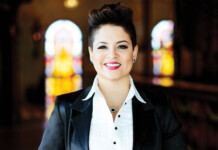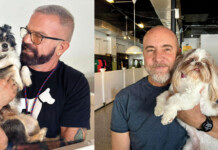Hotspots Exclusive Interview with Michael Kasten
 The World AIDS Museum (1201 NE 26th St., Ste. 111, Wilton Manors) opened to much fanfare on World AIDS Day last year, and since then they have welcomed thousands of visitors from all over the world who wish to learn about the impact HIV and AIDS have made on the global community over the past 35 years. “There’s no other physical facility, that we know of, that exclusively focuses on telling the story of HIV and AIDS,” Hugh Beswick, the CEO of the World AIDS Museum, told Hotspots. “We’re in a pretty unique position to impact the world.”
The World AIDS Museum (1201 NE 26th St., Ste. 111, Wilton Manors) opened to much fanfare on World AIDS Day last year, and since then they have welcomed thousands of visitors from all over the world who wish to learn about the impact HIV and AIDS have made on the global community over the past 35 years. “There’s no other physical facility, that we know of, that exclusively focuses on telling the story of HIV and AIDS,” Hugh Beswick, the CEO of the World AIDS Museum, told Hotspots. “We’re in a pretty unique position to impact the world.”
World AIDS Museum Video from Leprika Productions on Vimeo.
As far as ongoing projects are concerned, the World AIDS Museum is reaching out to the community and teaching schoolchildren about safer sex practices, as well as organizing new interactive exhibits which will hopefully not just educate people who go to the museum, but eventually people all over the world via the Internet.
I spoke with Michael Kasten, President of the World AIDS Museum’s Board of Directors, about the projects they are currently working on or exhibiting in this exclusive Hotspots interview.
I heard that you all are working with Broward County Schools for a project. Can you give us an overview?
 Through contacts made with Hugh Beswick, our CEO, we developed an HIV/STI safe sex education program for middle and high school students in Broward County. The program consists of a PowerPoint presentation, and it also has video in it as well as interactive components. One of our board members is also on the Broward County School Board, and her work has really helped us bring our message to the schools.
Through contacts made with Hugh Beswick, our CEO, we developed an HIV/STI safe sex education program for middle and high school students in Broward County. The program consists of a PowerPoint presentation, and it also has video in it as well as interactive components. One of our board members is also on the Broward County School Board, and her work has really helped us bring our message to the schools.
Broward County as a whole is failing when it comes to HIV prevention. The largest group that’s transmitting HIV nowadays is the younger crowd, and Broward County already taught sex education, but we weren’t really satisfied with it, so we presented them with this new project. Our project is called “In Ctrl…” like a control key on a keyboard, and the subtitle is “Educated Choices.” Everything has been approved now and we found two very young and enthusiastic teachers who will be teaching this program with two of our board members as well as Ed Sparan, our operations manager. In this first round of instruction, we will be in 27 different schools across the county. Some of the difficulty that comes from teaching kids aged 13-18 is that this kind of education can’t come with orders, no “Don’t do this” or “Don’t do that.” They’ll tune out. You have to show them graphically what the dangers are, and then empower them to make good choices.
 You’ve unveiled another project recently as well. Can you tell us about it?
You’ve unveiled another project recently as well. Can you tell us about it?
The other project is a videography called “Owning Up: Stories of Poz Millennials.” These stories all come from people ages 18 to 30 who either were infected with, or have been affected by, HIV. There are two different videos, one that’s three minutes long and features excerpts of each interview, and then a longer 30-minute piece. Part of that project will be shown to people who take the World AIDS Museum tour, and it will be on our YouTube  channel as well.
channel as well.
Then, later in the year, we will begin exhibiting our next video which will feature people over 50. The vignettes will all speak with people, like myself, who are 50 and over who are either infected or affected by HIV. These projects hope to expand our mission and our vision outside the confines of the museum space itself and will hopefully create a positive social change.
With all of these different video projects being showcased not just in the museum but also online, how is the museum trying to reach out to people who may not be able to visit Wilton Manors?
That’s a great question, and that’s one of our newest goals. We’ve built up our social media presence and our YouTube presence with that in mind. Our long-term goal is to build mobile museums which can travel all over the country and around the world. We are the World AIDS Museum, after all; we need to practice what we preach. We can’t exist with everything just inside the walls of the museum; we want to make our exhibits and our projects accessible to everyone. Our mission is to provide an interactive experience which documents the history and sheds the stigma of HIV and AIDS. To do that we need to continue to expand, both technology-wise and with our physical presence.
The World AIDS Museum is open to the public from 2 to 8 p.m. on Tuesdays, Wednesdays by appointment only, 2 to 8 p.m. on Thursdays, and noon to 8 p.m. on Fridays and Saturdays. For more information about the museum as well as the projects outlined above, call (954) 390-0550 or visit worldaidsmuseum.com.













